When we began renovations on our house in March 2007, the first step was to dig out under it to create a workspace for utility installation. Near the end of our dig we found a bottle with a piece of paper rolled up inside, looking much like it had served as a makeshift cork at one time, not as an intentional time capsule.
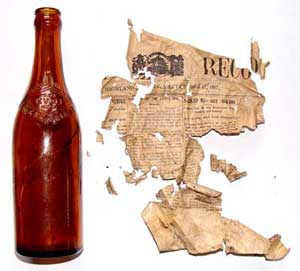
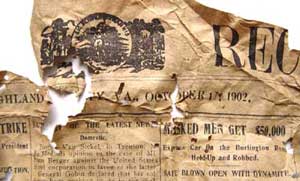
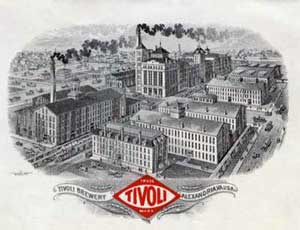
The paper turned out to be from The Recorder, our local paper, from 17 October 1902. We knew that the house was built just after 1900, so it now seems likely that 1902 is the year construction began. The bottle has molded lettering, “ROBERT PORTNER BREWING CO. ALEXANDRIA, VA” and the word “TIVOLI” in the center. Portner was founded during the Civil War and became one of the largest breweries in the south prior to closing at the onset of Prohibition in 1916. The Alexandria Archaeology Museum offers a brief description of Portner Brewery as well as a more detailed report. [248 kB pdf] This archaeological tidbit sent me on a quest for more information. My first step took me to the library’s microfilm files for the complete page 1 of The Recorder for 17 October 1902. [264 kB gif image] Note the wonderful advertisement at the upper right. The text is hard to read at this scale but the full-size image is over 6 MB. The idea is to give a flavor of the time and place, not necessarily a readable newspaper. Be sure to zoom your browser to expand the initial small image.

I next went to the courthouse and found the above deed. John H. Pruitt bought a 7.25 acre tract for $195 on 29 October 1902. For some reason the deed was not recorded until 6 October 1903. The property appears as an addition written in between the lines of the 1903 Highland County Land Book, at which time the land was assessed at $1.27 per acre. The house first showed up in the 1904 Land Book, assessed at $100. Total property tax for the year was 38 cents. By 1906 the land value had jumped to $3.00 per acre and the total tax to 42 cents. This tract is the core piece of our present farm. At the time of this purchase John Pruitt already owned jointly with his father a 74 acre tract that adjoined his new home site on the west, 44 acres of which remains a part of our farm. This tract was assessed at 30 cents per acre with a tax of eight cents per year.
The original part of the house is a basic two-over-two, 16 by 32 feet. It has no real foundation yet it is quite sturdy, with 8 x 8 oak beams laid on large stones around the perimeter, supporting 2 x 8 oak floor joists. The one-story part on the north side, which we are renovating, probably was a part of the original construction. We will surely learn more as we tear into it.
16 June 2007: After tearing off a good deal of siding it is now clear that the one-story part was added some time later. It is attached over exterior siding on the main house and the clapboard on the addition is pine while the main house is chestnut. We also talked to a neighbor who has lived here for over 80 years, who believes the addition was made in the 1930s. The metal roofs on both parts were clearly done at the same time but they are not as old as we thought. When I raised a corner of the addition roof I was surprised to find an old asphalt-shingle roof under it. That probably lasted about 20 years so the metal roof may date to the 1950s. We will surely learn more about that later.
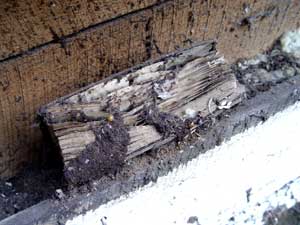

When we removed the siding on the west end of the main house, we discovered several artifacts. The most interesting was a book lying at the bottom of a stud space, shown in place at left. It is an algebra text, published in 1874, belonging to the original owner of the house. The inscription reads, “Jno H Pruitt’s Book, Monterey, Virginia.” The book is filled with dirt. I will write more about it after it is cleaned up.
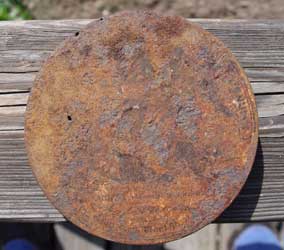
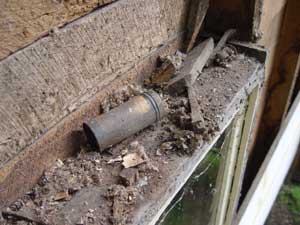
The can at left is a flat can with a slip top, about four inches in diameter. It was in a stud space near the book. I can make out a few words of the label but nothing definitive. It may have been a salve of some sort or possibly shoe polish. Today it contains a hard gray material. The can at right is shown in place along with other debris, just above the first-floor window. A portion of the label is legible and begins, “The Superiority of this Powder over . . . ” I believe it contains talcum powder but I have not been able to get it open.